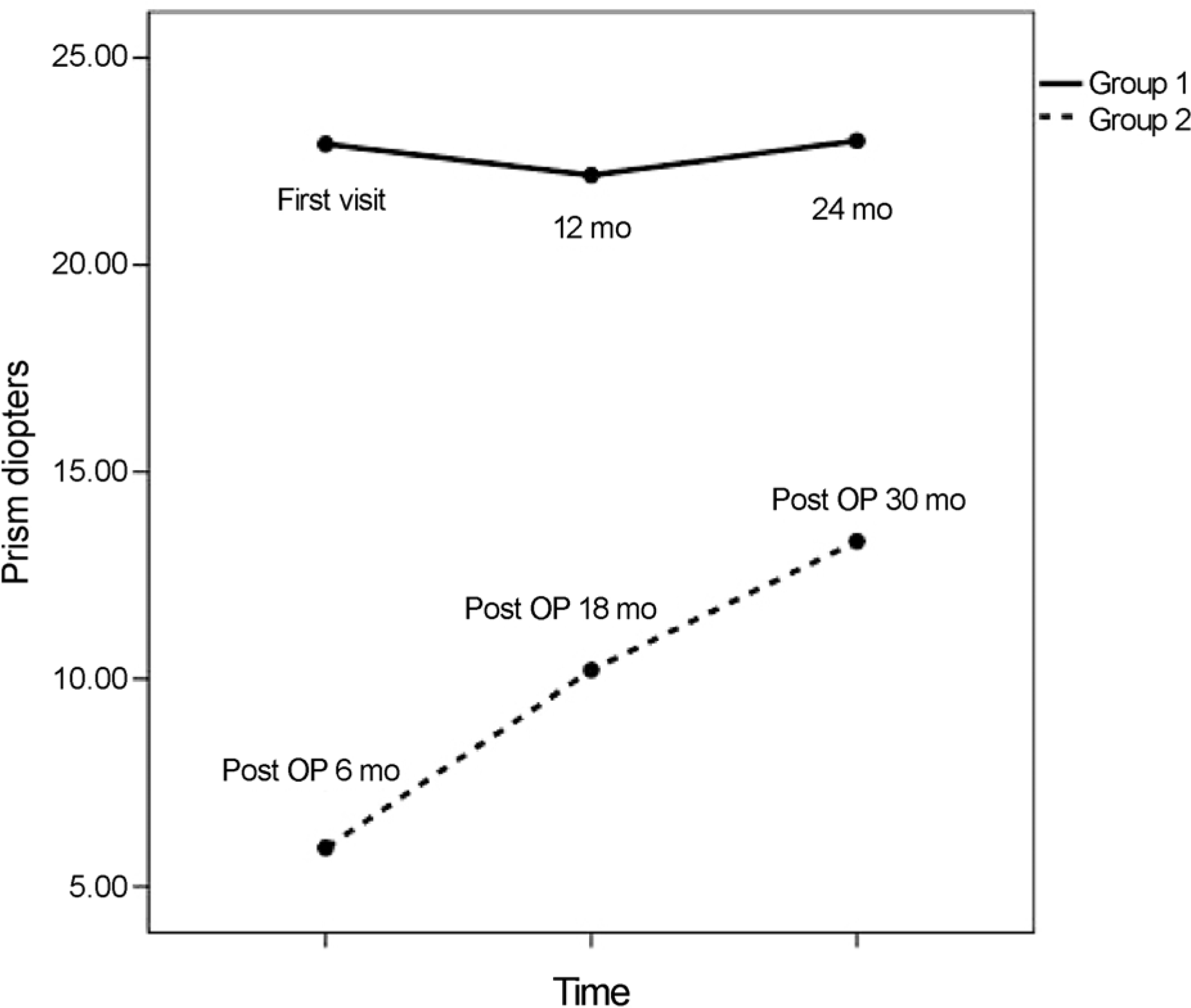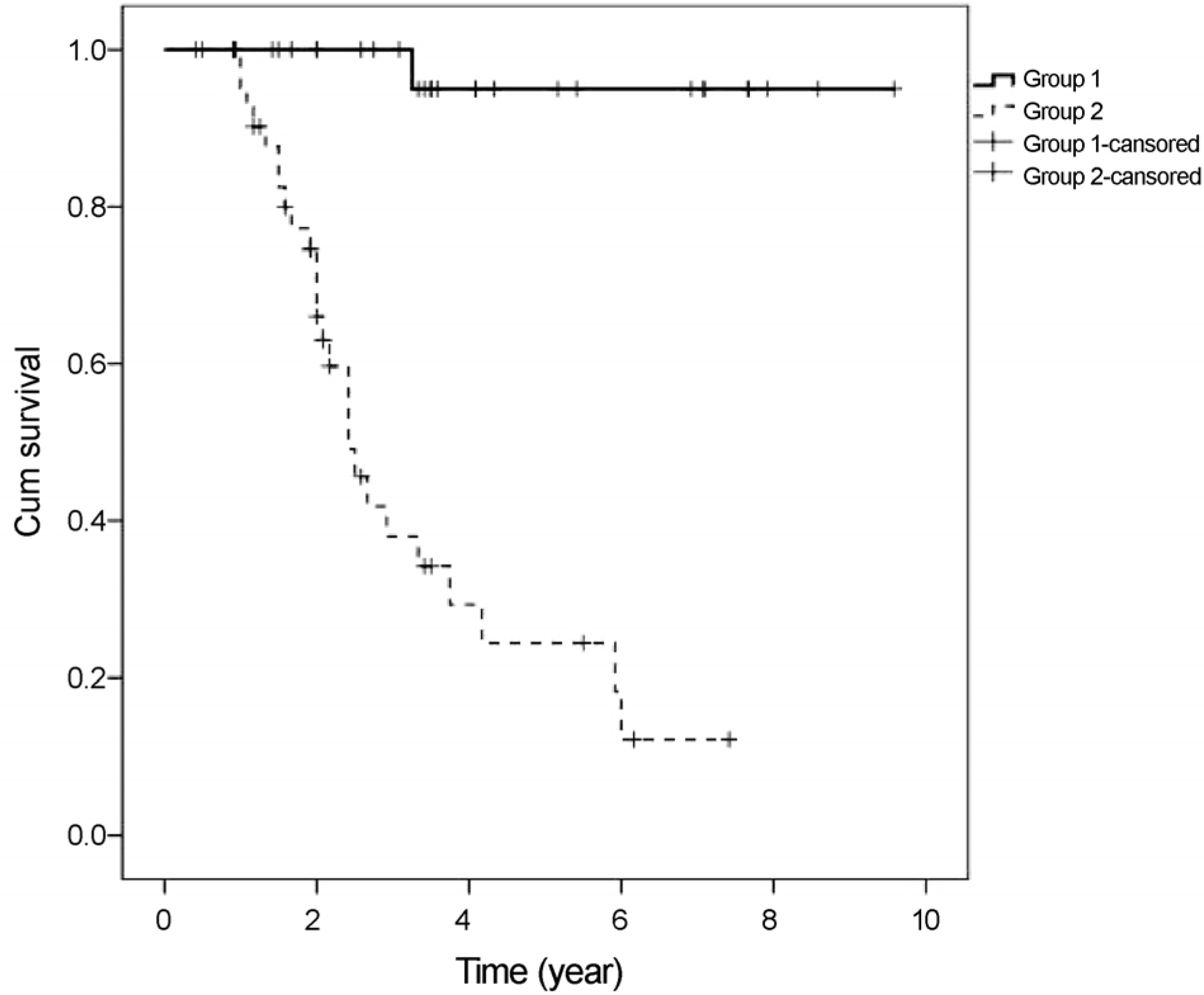1. Jenkins R. Demographics: geographic variations in the prevalence and management of exotropia. Am Orthopt J. 1992; 42:82–7.

2. Park DG, Moon SH, Noh DH, Kim MM. Comparison between 20 and 25 prism diopters in bilateral rectus muscle recession for abdominal exotropia. J Korean Ophthalmol Soc. 2014; 55:1669–73.
3. von Noorden GK, Campos EC. Binocular vision and ocular abdominal: theory and management of strabismus. 6th ed.St. Louis: Mosby;2002. p. 631.
4. Burian HM. Exodeviations: their classification, diagnosis, and treatment. Am J Ophthalmol. 1966; 62:1161–6.

5. Scott WE, Keech R, Mash AJ. The postoperative results and stabdominal of exodeviations. Arch Ophthalmol. 1981; 99:1814–8.
6. Ruttum MS. Initial versus subsequent postoperative motor abdominal in intermittent exotropia. J AAPOS. 1997; 1:88–91.
7. Reynolds JD, Hiles DA. Single lateral rectus muscle recession for small angle exotropia. Reinecke RD, editor. Strabismus 2: Proceedings of the Fourth Meeting of the International Strabismological Association, October 25–29, 1982, Asilomar, California (Pt. 2). New York: Grune & Stratton;1984. p. 247–53.
8. Kushner BJ. Selective surgery for intermittent exotropia based on distance/near differences. Arch Ophthalmol. 1998; 116:324–8.

9. Lee SH, Kim JY, Kwon JY. The effect of unilateral lateral rectus abdominal for the treatment of moderate-angle exotropia. J Korean Ophthalmol Soc. 2005; 46:2045–9.
10. Spierer O, Spierer A, Glovinsky J, Ben-Simon GJ. Moderate-abdominals exotropia: a comparison of unilateral and bilateral rectus abdominal recession. Ophthalmic Surg Lasers Imaging. 2010; 41:355–9.
11. Menon V, Singla MA, Saxena R, Phulijele S. Comparative study of unilateral and bilateral surgery in moderate exotropia. J Pediatr Ophthalmol Strabismus. 2010; 47:288–91.

12. Moon KJ, Choi WC, Park C. The long-term effect of unilateral abdominal rectus muscle recession for moderate angle exotropia. J Korean Ophthalmol Soc. 1998; 39:1885–90.
13. Hiles DA, Davies GT, Costenbader FD. abdominal observations on unoperated intermittent exotropia. Arch Ophthalmol. 1968; 80:436–42.
14. Sanfilippo S, Clahane AC. The effectiveness of orthoptics alone in selected cases of exodeviation: the immediate results and several years later. Am Orthopt J. 1970; 20:104–17.

15. Kii T, Nakagawa T. Natural history of intermittent exotropia–stat-istical study of preoperative strabismic angle in different age groups. Nippon Ganka Gakkai Zasshi. 1992; 96:904–9.
16. Romanchuk KG, Dotchin SA, Zurevinsky J. The natural history of surgically untreated intermittent exotropia-looking into the distant future. J AAPOS. 2006; 10:225–31.

17. Yang HK, Hwang JM. Bilateral vs unilateral medial rectus abdominal for recurrent exotropia after bilateral lateral rectus recession. Am J Ophthalmol. 2009; 148:459–65.
18. Cho SC, Yang HK, Hwang JM. Three-year surgical outcome of exotropia. J Korean Ophthalmol Soc. 2012; 53:1674–9.

19. Lee JC, Lee YC, Lee SY. Comparison of postoperative outcomes according to deviation angle in moderate-angle intermittent abdominal of basic type. J Korean Ophthalmol Soc. 2013; 54:475–8.
20. von Noorden GK. Binocular vision and ocular motility: theory and management of strabismus. 4th ed.St. Louis: CV Mosby;1990. p. 330–9.
21. Stathacopoulos RA, Rosenbaum AL, Zanoni D, et al. Distance stereoacuity. Assessing control in intermittent exotropia. Ophthalmology. 1993; 100:495–500.
22. Zanoni D, Rosenbaum AL. A new method for evaluating distance stereo aciuty. J Pediatr Ophthalmol Strabismus. 1991; 28:255–60.
23. Roh YB, Kim CM, Oum BS, Lee JS. Distance stereoacuity in abdominal with intermittent exotropia using B-VAT II video acuity tester. J Korean Ophthalmol Soc. 1998; 39:578–82.
24. Suh WJ, Lee UK, Kim MM. Change of postoperative distance abdominal in intermittent exotropic patients. J Korean Ophthalmol Soc. 2000; 41:758–63.
25. O'Neal TD, Rosenbaum AL, Stathacopoulos RA. Distance stereo acuity improvement in intermittent exotropic patients following strabismus surgery. J Pediatr Ophthalmol Strabismus. 1995; 32:353–7. discussion 358.
26. Beneish R, Flanders M. The role of stereopsis and early abdominal alignment in long-term surgical results of intermittent exotropia. Can J Ophthalmol. 1994; 29:119–24.
27. Baker JD, Davies GT. Monofixational intermittent exotropia. Arch Ophthalmol. 1979; 97:93–5.

28. Kim JH, Kim SH, Cho YA. A Study of patient concerns and return to daily life after strabismus surgery. J Korean Ophthalmol Soc. 2012; 53:440–5.

29. Baek SU, Lee JY. abdominal outcome of surgery for intermittent exotropia. J Korean Ophthalmol Soc. 2013; 54:1079–85.
30. Cho YA, Lee JK. Early surgery before 4 years of age in intermittent exotropia. J Korean Ophthalmol Soc. 2004; 45:620–5.
31. Ing MR, Nishimura J, Okino L. Outcome study of bilateral lateral rectus recession for intermittent exotropia in children. Ophthalmic Surg Lasers. 1999; 30:110–7.

32. Kim MM, Cho ST. abdominal surgical results of intermittent exotropia. J Korean Ophthalmol Soc. 1994; 35:1321–6.
33. Nelson LB, Bacal DA, Burke MJ. An alternative approach to the surgical management of exotropia–the unilateral lateral rectus recession. J Pediatr Ophthalmol Strabismus. 1992; 29:357–60.

34. Weakley DR Jr, Stager DR. Unilateral lateral rectus recessions in exotropia. Ophthalmic Surg. 1993; 24:458–60.

35. Roh YB, Choi HY. Surgical results of unilateral and bilateral lateral rectus recessions in exotropia under 25 prism diopter. J Korean Ophthalmol Soc. 1997; 38:474–8.
36. Cho HJ, Ma YR, Park YG. Comparison of surgical results between bilateral and unilateral lateral rectus recession in 20∼ 25 prism abdominal intermittent exotropia. J Korean Ophthalmol Soc. 2002; 43:1993–9.
37. Rabb EL, Parks MM. Recession of the lateral recti. Early and late postoperative alignments. Arch Ophthalmol. 1969; 82:203–8.
38. Knapp P. Symposium on strabismus: transactions of the New Orleans Academy of Ophthalmology. St. Louis: CV Mosby;1971. p. 233–41.
39. Roh JH, Paik HJ. Clinical study on factors associated with abdominal and reoperation in intermittent exotropia. J Korean Ophthalmol Soc. 2008; 49:1114–9.
40. Lee S, Lee YC. Relationship between motor alignment at abdominal day 1 and at year 1 after symmetric and asymmetric abdominal in intermittent exotropia. Jpn J Ophthalmol. 2001; 45:167–71.
41. Elsas FJ. Consecutive esotropia. Am Orthopt J. 1992; 42:94–7.

42. Duane A. A New Classification of the Motor Anomalies of the Eye: Based upon Physiological Principles, Together with Their Symptoms, Diagnosis and Treatment. New York: J.H. Vail & Co.;1897. p. 49–51.
43. Bielschowsky A. Divergence excess. Arch Ophthalmol. 1934; 12:157–66.







 PDF
PDF ePub
ePub Citation
Citation Print
Print


 XML Download
XML Download